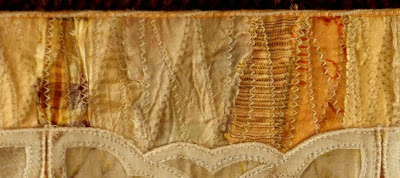I'm sure many of you can identify with the frustration of not finding the right fabric for a specific project. For me personally it was also one of the frustrations of living in a smaller city/town where quilt shops were a luxury in the 1990's! Online shopping was via the mail order era of the 1990's!
I was working on my quilt entry for the 1994 SA National Quilt Festival and the deadline was slowly but surely creeping up on me. To my frustration, I could not find any suitable fabric for the border section of my quilt. After thinking about this for many days, I had the brainwave to paint a piece of fabric which would be the perfect match for my quilt! I rushed off to buy a nice quality calico, paint brushes, fabric paint and excitedly set up a painting station in my sewing room! I was ready to paint a masterpiece that would take my quilt to the next level...! Oh dear, I froze and could not do anything that looked remotely decent. I had a deadline and the panic struck as I heard the clock ticking...! After a few attempts, I managed to paint a piece which had all the right colours and effects that I needed (but it wasn't wonderful!) It did the job and looked right for the project. From there on I regularly dabbled with fabric paints as I enjoyed the mess I created! Fabric painting solved my problem of finding suitable fabric for the realistic nature & wildlife quilts I created during that phase.
This piece was similar to the very first piece of fabric I painted for a competition quilt in 1994
I began giving gifts of hand painted fabric to quilting friends until one suggested that I should paint fabric to sell... As I always love a challenge, I decided to give it a go! Brush Rags was born in 2001 and I started selling my fabrics at the Dias Quilters' Guild meetings. The "brush" indicates that the fabric was painted with a brush and the "rags" refers to pieces of fabric. As painting fabric is so different to the dyeing process, I'm limited with the sizes of fabric which I paint. Once the paint is applied to the fabric, it must dry undisturbed on the surface onto which it was painted otherwise it smudges! That is why brush rags are only available in fat quarters as my paint boards are cut to that size. The other problem is the length of my arms - it is a challenge to handle bigger boards. The weather has a huge impact on fabric painting - if the atmosphere is very damp, I don't even try to paint as the fat quarters don't dry properly especially if I use salt techniques. It is the best to dry the fabric in the sun as it dries the paint properly after which it rests in the studio for at least a week before I fix the painted surfaces and start the cleaning process.
I started off by painting simple techniques on a lovely quality of calico, some of the techniques are still part of my regular stock. Unfortunately most of our textile factories who produced good quality calico have closed down and I had to switch to another fabric. I chose percale cotton which is available locally. Although the thread-count is higher than calico, the quality is consistent which is important! Brush Rags are very suitable for raw edge applique techniques as it does not fray.
Brush Rags - the beginning...
I regularly experiment and try to produce new finishes to make it exciting for me to paint. I introduced a few new lines this year which seems to be very popular with quilters, the highlight was when Helen Godden from Australia bought some of the fabric at the 2019 National Quilt Festival at Heronbridge and was so kind to make a video clip of the fabric to promote Brush Rags. I usually paint a range of different finishes in the same colours. The following swatches are some of the current stock:
4 different finishes in orange, cerise and purple.
Jade, blue and purple
Olive, purple and gold
Rust, gold and navy
Orange, cerise and red
Grey
Earlier in the year I started discharging black cotton fabric which gives very dramatic finishes. Here are swatches of the latest batch:
A selection of discharged black fabric.
I also started rusting fabric - great fun and lovely results, but so messy and rough on the hands.... I find it difficult to work with gloves as my hands are too clumsy then!
Rust Rags - some over-painted.
The thrill of painting fabric is to see how I can transform an ordinary piece of white fabric into a piece of art... After the whole process of washing the fabric, cutting into fat quarters, painting every piece, drying, ironing to fix the paint, washing again to get rid of paint residue and salt, ironing with the press and the final folding and packaging of the fat quarters - a labour intensive process but oh so satisfying...! Some finishes take one or two applications of paint, others take up to 6 - 8 applications to build up the design/colour. Because the process is so labour intensive, I made the choice to keep it small to enable me to teach quilting, be a quilter and still have a life apart from quilting!



























